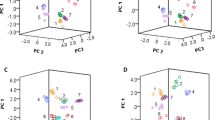Abstract
We have developed a new method to make a clear distinction between edible oil and refined recycled cooking oil by using a micro-ultraviolet spectrophotometer and analysis of spectra full data combined with principal component analysis (PCA) and cluster discriminant analysis (CDA). This method shows an excellent capability of distinguishing edible oil from refined recycled cooking oil, which is difficult to accomplish by previous methods using physical and chemical properties. Edible oils and refined recycled cooking oils have the different positions on the resulting plot of PCA and CDA. The oil samples are respectively concentrated relatively distribution and distinct from other kinds, with a certain amount of edge intersection between samples. But the edible oil and refined recycled cooking oil samples have a clear divisional interface. By the increase in sampling and the improvement of modeling, the edge intersection or overlap of commonality between samples can be reduced. Using this method, it is possible to determine qualitatively the identity of unknown samples.







Similar content being viewed by others
References
Mavromoustakosa T, Zervoua M, Bonasa G, Kolocouris A, Petrakis P (2000) A novel analytical method to detect adulteration of virgin olive oil by other oils. J Am Oil Chem Soc 77(4):405–411
Su R, Feng X, Yu A, Zhang H, Wang X (2012) Application of real-time refrigeration turbidimetry for rapid discrimination and purity assessment of refined peanut oils adulterated with other seed oils. Eur Food Res Technol 234:165–172
Giacomelli LM, Mattea M, Ceballos CD (2006) Analysis and characterization of edible oils by chemometric methods. J Am Oil Chem Soc 83:4303–4308
López-Beceiro J, Artiaga R, Gracia C, Tarrıó-Saavedra J, Naya S, Mier JL (2011) Comparison of olive, corn, soybean and sunflower oils by PDSC. J Therm Anal Calorim 104:169–175
Al-Degs YS, Al-Ghouti MA, Salem N (2011) Determination of frying quality of vegetable oils used for preparing falafel using infrared spectroscopy and multivariate calibration. Food Anal Methods 4:540–549
Tan CP, Man YBC (2000) Differential scanning calorimetric analysis of edible oils: comparison of thermal properties and chemical composition. J Am Oil Chem Soc 77(2):143–155
Jahaniaval F, Kakuda Y, Marcone MF (2000) Fatty acid and triacylglycerol compositions of seed oils of five Amaranthus accessions and their comparison to other oils. J Am Oil Chem Soc 77(8):847–852
Aparicio R, Aparicio-Ruız R (2000) Authentication of vegetable oils by chromatographic techniques. J Chromatogr A 881(1–2):93–104
Cunha SC, Oliveira MBPP (2006) Discrimination of vegetable oils by triacylglycerols evaluation of profile using HPLC/ELSD. Food Chem 95(3):518–524
Cozzolino D, Murray L, Chree A, Scaife JR (2005) Multivariate determination of free fatty acids and moisture in fish oils by partial least-squares regression and near-infrared spectroscopy. LWT—Food Sci and Technol 38(8):821–828
Mirghani MES, Man YBC, Jinap S, Baharin BS, Bakar J (2002) FTIR spectroscopic determination of soap in refined vegetable oils. J Am Oil Chem Soc 79(2):111–116
El-Abassy RM, Donfack P, Materny A (2009) Rapid determination of free fatty acid in extra virgin olive oil by Raman spectroscopy and multivariate analysis. J Am Oil Chem Soc 86:507–511
Caja MM, Ruiz del Castillo ML, Herraiz M, Blanch GP (1999) Study of the enantiomeric composition of chiral constituents in edible oils by simultaneous distillation-extraction: detection of adulterated olive oils. J Am Oil Chem Soc 76(9):1027–1030
Vlachos N, Skopelitis Y, Psaroudaki M (2006) Applications of Fourier transform-infrared spectroscopy to edible oils. Anal Chim Acta 573–574:459–465
Poulli KI, Mousdis GA, Georgiou CA (2009) Monitoring olive oil oxidation under thermal and UV stress through synchronous fluorescence spectroscopy and classical assays. Food Chem 117(3):499–503
Wang Y, Ping-he Y, Fang-hui L, Zhao L, Liu W (2006) Distinguishing recycled cooking oil from peanut oil by ultraviolet-visible spectrophotometer. Chin J of Lab Anal 25(3):92–94
Tsimidou M, Macrae R (1987) Authentication of virgin oils using principal component analysis of triglyceride and fatty acid profiles: part 2—detection of adulteration with other vegetable oils. Food Chem 25(4):251–258
Acknowledgments
This work was supported by Zhejiang Provincial Natural Science Foundation of China (Grant No. Y4110235) and Zhejiang Provincial Bureau of Quality and Technical Supervision (Grant No. 20110236). We are delighted to acknowledge the assistance of Dr. Zhen Li and Dr. Greg Duns in revising the English of the paper and discussions with colleagues in our research group.
Author information
Authors and Affiliations
Corresponding author
About this article
Cite this article
Liu, Tb., Zhou, Y., Lv, J. et al. Authentication of Edible Vegetable Oil and Refined Recycled Cooking Oil Using a Micro-UV Spectrophotometer Based on Chemometrics. J Am Oil Chem Soc 90, 1599–1606 (2013). https://doi.org/10.1007/s11746-013-2311-3
Received:
Revised:
Accepted:
Published:
Issue Date:
DOI: https://doi.org/10.1007/s11746-013-2311-3




